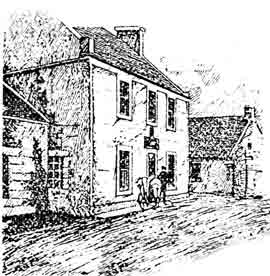The Old Inn.
Carmunnock.

Old Inn, Carmunnock, 1894.
The Old Inn, Carmunnock, was a plain old fashioned inn, externally and internally. In the front wall of an adjoining out-house may be traced the date 1793, the inn itself was even older. It contained seven apartments, two of which , the sitting-room and the kitchen, were on the ground floor. The sitting-room, was small, neat and comfortable. A cheery fire burned in an old grate, with its knobs of shining teel; "Mrs Mew," a favourite cat, sat demurely on the hearth, effected in nowise, it was evident, by the presence of a stranger.
The kitchen was very old, it looked as if nothing had been changed in it since the beginning of the 1800s. The wide fireplace, dish racks, cupboards, curtained, naked joists and stone floor, ornamented by this and the other design in chalk, all belong to the old-fashioned country inn of a three hundred years ago. Over the doorway, embellished by a representation of the rose, the thistle and the shamrock, each entwined within the other, the name is Orlando Young.
Mr Young, however was deceased. The business, which has been in the hands of the Young family for upwards of a half a century, was carried on by his widow, assisted by a daughter. Many years ago a social club met here at intervals, the members of which came all the way from the city. They were jovial gentlemen, it would seem. One a year they had a grand feast of herrings and potatoes, when songs were sung and stories told and bumpers drunk with a heartiness and hilarity that, so to speak, knew no bounds.
As to the village of which the inn formed a part, it was one of the very oldest and quietest. There was not a straight street in Carmunnock and hardly three houses in a line. The houses were heaped and muddled together in conspicuous confusion, a feature that was thoroughly English. The agree, or bit of common ground, was also a characteristic of the English village. If English in these respects, it was Scotch in every other, except, perhaps, the sign already referred to over the doorway of the inn, which was broad and liberal in its meaning, and not all in keeping with the exclusive spirit manifest throughout the village.
The Parish Church was of great antiquity. It was a curious little structure, with an outside stair leading up and into the gallery. The belfry was an open one, and had just received a new bell. Through the kindness of the sexton. In size and weight it did not exceed what a man may lift. It was made in Belgium, and bears the Latin inscription, Michael Burgeryus me fecit, 1618 (Michael Burgery made me, 1618.) In the vestry there was a little library, a portion of which was allotted to the use of the children attending the Sabbath School. The other presents a good instance of the exclusive spirit already noticed. The works were all, or nearly all, those of Scotchmen.
End.
